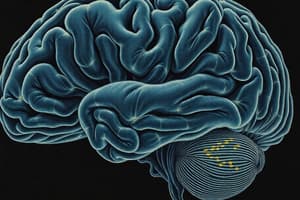Podcast
Questions and Answers
What is the primary focus of operant conditioning?
What is the primary focus of operant conditioning?
- The consequences that follow a response or behavior (correct)
- The influence of early life experiences on behavior
- The unconscious conflicts within an individual
- The acceptance of difficult emotions in therapy
Which model emphasizes the role of unconscious conflicts in explaining abnormal behavior?
Which model emphasizes the role of unconscious conflicts in explaining abnormal behavior?
- Psychoanalytic/psychodynamic model (correct)
- Psychological model
- Mindfulness/acceptance-based models
- Sociocultural model
Which part of the brain is critical to executive functioning?
Which part of the brain is critical to executive functioning?
- Prefrontal cortex (correct)
- Hippocampus
- Limbic system
- Occipital lobe
In terms of explaining mental disorders, the sociocultural model considers which of the following factors?
In terms of explaining mental disorders, the sociocultural model considers which of the following factors?
What is primarily involved in the process of transference during psychoanalytic therapy?
What is primarily involved in the process of transference during psychoanalytic therapy?
Which statement most accurately describes the role of the amygdala?
Which statement most accurately describes the role of the amygdala?
What differentiates reinforcement from punishment in behavior therapy?
What differentiates reinforcement from punishment in behavior therapy?
Which psychological model emphasizes multiple intersecting influences on mental disorders?
Which psychological model emphasizes multiple intersecting influences on mental disorders?
What is the primary focus of cognitive-behavioral therapy?
What is the primary focus of cognitive-behavioral therapy?
Which of the following best describes repression as a defense mechanism?
Which of the following best describes repression as a defense mechanism?
What does the diathesis-stress model explain regarding mental disorders?
What does the diathesis-stress model explain regarding mental disorders?
What is the purpose of dream analysis according to psychoanalytic theory?
What is the purpose of dream analysis according to psychoanalytic theory?
Which term describes the proportion of observed differences in a sample attributable to genetic variations?
Which term describes the proportion of observed differences in a sample attributable to genetic variations?
What is the focus of the humanistic/person-centered model of psychological disorders?
What is the focus of the humanistic/person-centered model of psychological disorders?
Which brain structure is closely associated with survival drives?
Which brain structure is closely associated with survival drives?
Flashcards are hidden until you start studying
Study Notes
Brain Structures & Functions
- Amygdala: Part of the limbic system responsible for evaluating sensory information and regulating emotions and impulses.
- Hypothalamus: Involved in drives related to survival, regulates the endocrine system.
- Prefrontal Cortex: Located in the frontal lobe and critical for executive functioning, including memory, planning, and problem-solving.
Models of Abnormal Behavior
- Biological Model: Focuses on biological factors like genetics, neurochemistry, and nervous system functioning to explain mental disorders.
- Psychological Model: Includes learning, personality, stress, cognition, self-efficacy, and early life experiences as contributing factors.
- Psychodynamic/Psychoanalytic Model: Associated with Freud, emphasizes unconscious conflicts and maladaptive defense mechanisms as root causes.
- Humanistic/Person-Centered Model: Associated with Carl Rogers, emphasizes inconsistency between behavior and true identity leading to lack of self-worth and self-acceptance.
- Behavioral/Cognitive Behavioral Model: Focuses on dysfunctional thoughts, emotions, and learned behaviors as the cause of psychopathology.
- Cognitive-Behavioral Therapy: Aims to identify and change destructive thought patterns impacting behavior and emotions. It includes cognitive restructuring and cognitive coping skills training.
- Mindfulness/Acceptance-Based Models: Emphasizes acceptance of difficult emotions and present moment focus.
- Biopsychosocial Model: Integrates biological, psychological, and social-cultural influences to explain mental disorders.
Concepts & Processes
- Defense Mechanisms: Coping strategies that protect from emotional distress, but can become maladaptive when misused.
- Repression: Blocking unacceptable ideas, wishes, or memories from consciousness.
- Denial: Refusing to acknowledge or accept reality to avoid overwhelming emotions.
- Regression: Reverting to immature behaviors in the face of stress.
- Diathesis-Stress Models: Individuals may inherit a vulnerability (diathesis) that can be activated by stress.
- Gene X Environment Interaction: The likelihood of a behavioral outcome depends on genetic potential interacting with specific environmental conditions.
- Heritability Coefficient (h2): Measures the proportion of differences in a trait attributable to genetic factors.
- Learning: Any relatively permanent change in behavior due to experience and practice.
- Operant Conditioning: A type of learning where consequences following a behavior either increase or decrease the likelihood of the behavior occurring again.
- Maladaptive Cognitions: Irrational thought patterns.
- Free Association: A psychoanalytic technique where patients describe whatever comes to mind during session.
- Dream Analysis: Used to understand unconscious wishes by examining the manifest (actual) and latent (hidden) content of dreams.
- Transference: In psychoanalytic therapy, patients transfer feelings and attitudes held towards past figures onto the therapist.
Studying That Suits You
Use AI to generate personalized quizzes and flashcards to suit your learning preferences.




